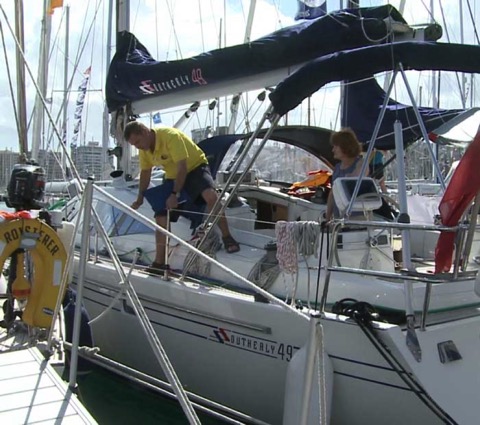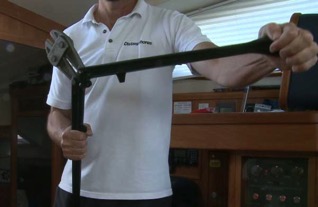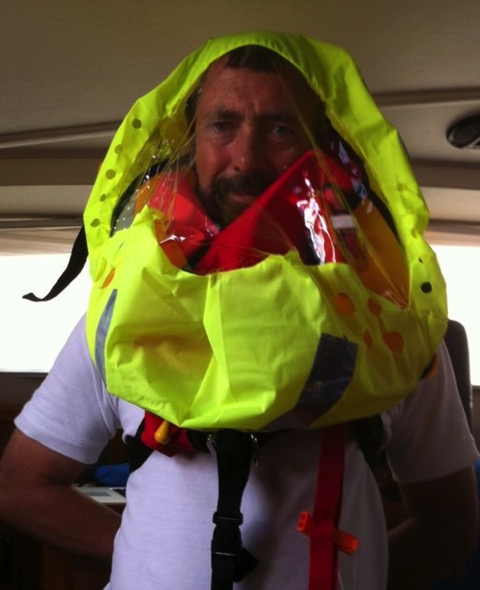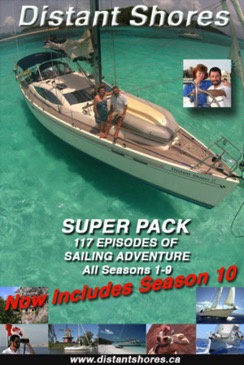Safety Inspection - ARC
21/11/12 02:58 Filed in: Offshore sailing
One of the prerequisites of participating in the ARC is to pass a safety inspection. Many cruisers are worried about this as they haven’t done ocean racing before and will not have had such an inspection in the past. I thought I would describe how the inspection went on Distant Shores II.
For many years all offshore races have had safety requirements to insure boats meet a minimum requirement for seaworthiness and safety. For an offshore rally it is the same, and the ARC has borrowed from the Ocean Racing community to make up their requirements. Many of the boats taking part have never crossed an ocean before, and even if they have, an inspection reminds us to focus on the important things and get the boat safe for sea.
The ARC information pack (check here for info) includes specific details for required safety equipment so most people have got a handle on the items they will need to upgrade before they reach Las Palmas. Most of the items will already be installed on the average cruising boat. A VHF with external speaker, a bilge pump operable from on deck, a SOLAS approved EPIRB, jacklines to clip on while going forward etc.
However, a number of items regularly give people trouble. For instance, we use a powerful rechargeable handheld spotlight, but the ARC requires the spotlight to be plugged into ships power. There was a huge pile of these spotlights in the chandlery last week, mostly gone now, indicating it is a common problem. So I have just finished installing and wiring up a 12Volt outlet by the helm.
The ARC also requires a very specific liferaft standard - which is another major consideration as it is quite a pricey piece of equipment. The raft must be either an ISO9650-1 standard, or SOLAS or ISAF (Racing). Most commonly found is the ISO-9650 standard. However, our liferaft (just 2.5 years old) is not an ISO certified raft and therefore failed the test. We have had to purchase a new one - 1800Euro - OUCH!! The new one comes today...

Inspection Day
Our inspector, Rob, arrived with a cheerful smile and described the procedure for the inspection, normally taking less than an hour. Normally he chats with the skipper to determine the experience and sailing history, and to try to put people at ease - it does feel slightly like a test... Next we follow him around the deck as he notes our nice tight lifelines with lashings so they can be cut away to get a man out of the water easily. He tugs on our jacklines and glances at the rigging as we head forward. In 15 minutes we have been around the deck and are back in the cockpit to inspect the emergency steering system. I point out that our Southerly has 2 duplicate steering systems, each with a wheel driving a rudder, and a beefy link arm between them. However, Northshore also fitted a backup for the backup with an additional spare tiller arm. Although we don’t need this for the ARC inspection I get it out and fit it anyway since I have never actually tried it before. It seems to work fine although I wouldn’t want to steer far with it ;-)
We demonstrate the external/manual bilge pump, check clipping on points in the cockpit and admire my new 12V outlet for the spotlight.

Heading down below we look at tie-downs for heavy equipment to make sure items like the batteries are well secured. We notice our stove clip needs adjusting as it is not correctly clipped. If the boat went over past 90 degrees the forward gimbal would fall out. Quickly corrected... We also pull out our bolt cutters for clearing away rigging.
In the bilge we check there are bungs ready to go by the thru-hulls. We get out our grab back, and check over our flares. Most boats will need to add a few flares to qualify for the ARC. They have a requirement for 4 white handheld flares as well as 6 SOLAS parachutes and 4 red handheld. I don’t know anyone who uses the white flares. The idea is to add light to a rescue scene. Personally I would never fire a flare just to add light - too much chance of an injury caused by the flare itself. Like everyone else we lined up in the fabulous local chandlery "Rolnautic" and added the required flares. As they work with the ARC directors, they know in advance which are the tricky items everyone will need. They have boxes of white flares!
Lifejackets are another interesting one. If you are a US flagged vessel you can get a way with USCG Type-1 jackets. Everyone else will need jackets with a crotch-strap and also a face mask. These are also available in Rolnautic nearby. We purchased these attractive facemasks to add to our existing inflatable jackets along with the light and whistle we already had stuffed inside them....

The rest of the inspection was relatively straight-forward, but we still had a middling list of small items for the chandlery.
Check out the following video from the ARC.
Check out this EXTENDED video feature of the ARC Safety Check.
For the Whole Atlantic Rally Experience and much more check out our whole Season 9 set of programs - on DVD or Vimeo
Plan your passages around the world with us aboard Distant Shores

Order the Super Pack on DVD and get Season 1-10 Downloadable.
Order the Super Pack on Vimeo and we will send you the code for Season 10 as a bonus.
Why have a safety Inspection
For many years all offshore races have had safety requirements to insure boats meet a minimum requirement for seaworthiness and safety. For an offshore rally it is the same, and the ARC has borrowed from the Ocean Racing community to make up their requirements. Many of the boats taking part have never crossed an ocean before, and even if they have, an inspection reminds us to focus on the important things and get the boat safe for sea.
What are the safety requirements
The ARC information pack (check here for info) includes specific details for required safety equipment so most people have got a handle on the items they will need to upgrade before they reach Las Palmas. Most of the items will already be installed on the average cruising boat. A VHF with external speaker, a bilge pump operable from on deck, a SOLAS approved EPIRB, jacklines to clip on while going forward etc.
However, a number of items regularly give people trouble. For instance, we use a powerful rechargeable handheld spotlight, but the ARC requires the spotlight to be plugged into ships power. There was a huge pile of these spotlights in the chandlery last week, mostly gone now, indicating it is a common problem. So I have just finished installing and wiring up a 12Volt outlet by the helm.
The ARC also requires a very specific liferaft standard - which is another major consideration as it is quite a pricey piece of equipment. The raft must be either an ISO9650-1 standard, or SOLAS or ISAF (Racing). Most commonly found is the ISO-9650 standard. However, our liferaft (just 2.5 years old) is not an ISO certified raft and therefore failed the test. We have had to purchase a new one - 1800Euro - OUCH!! The new one comes today...

Inspection Day
Our inspector, Rob, arrived with a cheerful smile and described the procedure for the inspection, normally taking less than an hour. Normally he chats with the skipper to determine the experience and sailing history, and to try to put people at ease - it does feel slightly like a test... Next we follow him around the deck as he notes our nice tight lifelines with lashings so they can be cut away to get a man out of the water easily. He tugs on our jacklines and glances at the rigging as we head forward. In 15 minutes we have been around the deck and are back in the cockpit to inspect the emergency steering system. I point out that our Southerly has 2 duplicate steering systems, each with a wheel driving a rudder, and a beefy link arm between them. However, Northshore also fitted a backup for the backup with an additional spare tiller arm. Although we don’t need this for the ARC inspection I get it out and fit it anyway since I have never actually tried it before. It seems to work fine although I wouldn’t want to steer far with it ;-)
We demonstrate the external/manual bilge pump, check clipping on points in the cockpit and admire my new 12V outlet for the spotlight.

Heading down below we look at tie-downs for heavy equipment to make sure items like the batteries are well secured. We notice our stove clip needs adjusting as it is not correctly clipped. If the boat went over past 90 degrees the forward gimbal would fall out. Quickly corrected... We also pull out our bolt cutters for clearing away rigging.
In the bilge we check there are bungs ready to go by the thru-hulls. We get out our grab back, and check over our flares. Most boats will need to add a few flares to qualify for the ARC. They have a requirement for 4 white handheld flares as well as 6 SOLAS parachutes and 4 red handheld. I don’t know anyone who uses the white flares. The idea is to add light to a rescue scene. Personally I would never fire a flare just to add light - too much chance of an injury caused by the flare itself. Like everyone else we lined up in the fabulous local chandlery "Rolnautic" and added the required flares. As they work with the ARC directors, they know in advance which are the tricky items everyone will need. They have boxes of white flares!
Lifejackets are another interesting one. If you are a US flagged vessel you can get a way with USCG Type-1 jackets. Everyone else will need jackets with a crotch-strap and also a face mask. These are also available in Rolnautic nearby. We purchased these attractive facemasks to add to our existing inflatable jackets along with the light and whistle we already had stuffed inside them....

The rest of the inspection was relatively straight-forward, but we still had a middling list of small items for the chandlery.
Check out the following video from the ARC.
Stormy Seas Autopilot Steering Video
Stormy Sailing Sneak Peek
Check out this EXTENDED video feature of the ARC Safety Check.
For the Whole Atlantic Rally Experience and much more check out our whole Season 9 set of programs - on DVD or Vimeo
Plan your passages around the world with us aboard Distant Shores

Order the Super Pack on DVD and get Season 1-10 Downloadable.
Order the Super Pack on Vimeo and we will send you the code for Season 10 as a bonus.
blog comments powered by Disqus